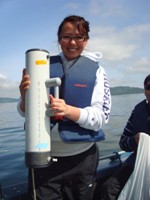| Home |
| About Us |
| Methods |
| Sample Sites
|
| Data Repository |
| Acknowledgements |
Quartermaster Harbor |
Methods: Water samples were obtained from each of the seven stations chosen at surface, thermocline and bottom depths. Surface and thermocline samples were collected through the use of a Thoreson Bottle. The Thoreson Bottle was drawn into the water by hand with the use of rope because of accessible depths. However, when collecting from the bottom a different device and method were used. The Nisken Bottle was used to sample bottom depths and due to the substantial wieght of the bottle that was hooked to the Conductivity Temperature Depth Device (CTD), the hauling was performed using a motorized reel. Dissolved Oxygen, Chlorophyll and Nutrient samples were collected from water obtained at all sample depths throughout each station's water column. Each sample was prepared and stored for further processing in the UWT L&L lab. Surface phytoplankton samples were captured using a 20 µm mesh plankton net, by dragging the net under the surface until ample phytoplankton were collected. Plankton net shown in picture 5 below. In addition to surface phytoplankton sampling, the Thoreson Bottle was used to obtain surface and thermocline phytoplankton samples. CTD profiles were taken at each station and determined the water stations salinity, temperature, depth and oxygen. A secchi disk device was used to determine the distance of visible light penetration through water. In order to collect sediment samples, a van veen device was attached to a rope and hand drawn down to the bottom. Sediment was collected at each station with the exception of #50 due to its deep waters and lack of rope attached to the van veen claw and #54 due to the non-yielding attempts after massive drift. Analysis was completed on the UWT campus in the lab photographed in picture 6.
|
Thoreson Bottle for Surface and Thermocline Sampline
Directing motorized reel to haul up CTD and Nisken bottle
Hauling up the CTD and Nisken Bottle
Preparing samples for Dissovled Oxygen Testing
Cleaning a surface plankton net
